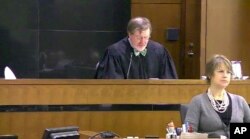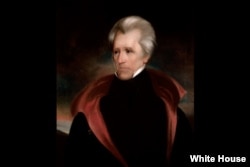China doesn't even have a “separation of powers,” but that didn't keep a prominent Chinese judge from weighing in when U.S. President Donald Trump lashed out at a federal judge who temporarily blocked the president's executive order on immigration.
Chinese Supreme People’s Court Judge He Fan called Trump an “enemy of the rule of law” for criticizing Judge James Robart.
Under the U.S. system of separation of powers, he wrote, a president should accept his loss silently and not attack the judge who ruled against him.
What is the separation of powers?
The U.S. Constitution set up three separate but equal branches of government: the legislative branch, or Congress, makes the law; the executive, led by the president, executes the law; and the judicial, or courts, interprets the law.
The idea is to divide power so each branch of government has its own powers and limits. But fights over how to apply these divisions of power have been frequent, up to and including Trump’s travel ban.
On January 27, President Trump signed an executive order to temporarily stop travel to the U.S. from seven Muslim majority nations.
After Judge Robart blocked his order, Trump went on Twitter to call Judge Robart a "so-called judge.” He said Robart’s decision was "ridiculous,” and opened the United States to possible terror attack.
On Tuesday, the federal appeals court in San Francisco heard arguments on whether Judge Robart’s order against Trump’s travel ban should be overturned. The court is expected to rule this week on the appeal from the Trump administration.
Josh Chafetz, a professor of law at Cornell University in New York, said Trump’s criticism was unusual, coming so early in his presidency. By calling Robart a “so-called judge,” Trump seems to be questioning his standing as a judge, Chafetz said.
Randy Barnett, a law professor of Georgetown University, sees Trump’s criticism of the judge as “mildly disrespectful.”
But he said it does not compare to President Barack Obama’s criticism of the Supreme Court during a 2010 speech before Congress. Obama was criticizing a Supreme Court decision that permitted unlimited donations to political campaigns.
Barnett said that the judges were in the audience as Obama criticized them. The Democrats in the audience stood and cheered.
Battles over separation of powers
There have been many battles among the three branches of government over separation of powers in U.S. history.
The Supreme Court’s first decision about “separation of powers” came in 1803. The court ruled it had the power to reject a law passed by Congress if it found the law unconstitutional.
In 1832, President Andrew Jackson did not like a decision by the Supreme Court, led by Justice John Marshall. The decision ended states’ law on land that belonged to Native American tribes.
Jackson reportedly said, “John Marshall has made his decision, now let him enforce it.”
Nearly 100 years later, President Franklin Roosevelt proposed to increase the number of justices on the Supreme Court from nine to 15. His critics accused him of trying to “pack the court.” They said he wanted to appoint justices supportive of his policies to get around opposition from the sitting justices. The proposal failed to pass in Congress.
Among the court’s other important rulings was a 1974 decision ordering President Richard Nixon to release tape recordings in what was known as the Watergate scandal. The scandal led to Nixon’s resignation.
Some legal experts have questioned whether Trump will comply with court orders. Barnett, the Georgetown professor, said it is a good sign that the Trump administration stopped the travel ban after Judge Robart’s ruling.
But Trump has argued that he feels strongly his immigration ban is needed. This is what he tweeted Wednesday morning:
“If the U.S. does not win this case as it so obviously should, we can never have the security and safety to which we are entitled. Politics!”










